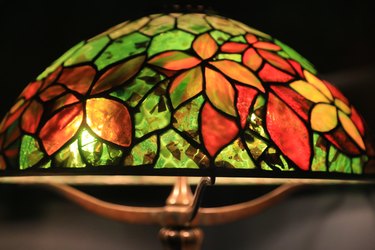
Authentic Tiffany lamps are highly prized for their beauty, craftsmanship and historical significance. Louis Comfort Tiffany, the son of the man who founded Tiffany & Co. Jewelry, founded Tiffany Studios and created these stunning lamps. Other manufacturers began creating Tiffany-style lamps. These lamps boast a similar design and aesthetic but aren't the real deal. Many Tiffany lamps have markings that can help you identify the authentic item.
Identify a Tiffany Lamp Base
Video of the Day
Tiffany lamps were created with a hollow, bronze base. Authentic Tiffany lamps have developed a patina over time. This is a normal reaction of bronze and oxygen and results in a brown or green hue. However, since the hollow bronze wasn't strong enough to support the stained glass, the creators added a lead ring to the base to provide support. You can see this grey ring when you look at the bottom of the lamp.
Video of the Day
Many Tiffany lamps will have a stamp on the base that identifies the maker as Tiffany Studios. This stamp may not be on the base of all lamps, so the lack of a stamp doesn't necessarily mean the lamp isn't authentic. If a stamp is present, it should read "TIFFANY STUDIOS NEW YORK" and display a makers mark. The text should be all capital letters of the same size, and the letters should be centered and straight. In rare cases, the stamp will be from another Tiffany company such as "Tiffany Furnaces, Inc.," "Louis C. Tiffany Furnaces, Inc," or "TGDCO" which stands for Tiffany Glass and Decorating Company.
Some lamps also have a serial number, which typically consists of just four numbers. A mixture of upper and lower case letters or a tilted or off-center stamp may indicate that the lamp isn't genuine.
Identify a Tiffany Lamp Shade
You may also find a marking on the lampshade to indicate the lamp is authentic. Look for the marking that is stamped on the inner metal rim. As with the base, the stamp should read "TIFFANY STUDIOS NEW YORK." If the lamp has a serial number, it will be positioned to the right of the stamp.
In addition to the marking, you can also examine the shade for quality to help determine its authenticity. Tiffany lampshades were created with leaded glass or blown glass and the beautiful colors are in the glass. If the glass was painted, it is not a Tiffany lamp.
You can also tap the glass to see if it is loose. Since these lamps are all older antiques, it is normal for the glass to be a bit loose and shake a bit when you tap it. If all of the glass is tightly secured, it may not be authentic.
Ensure Tiffany Lamp Authenticity
While the markings on a Tiffany lamp typically indicate the lamp is authentic, you still want to look at the other components of the lamp. For example, some Tiffany lamps may be oil lamps, but the electric ones will have a turn-paddle knob.
It is a good idea to have a professional examine the Tiffany lamp to ensure its authenticity. While these are all things you can look for, Tiffany lamps may be restored or rewired which can make it difficult to identify an original, which can be incredibly valuable. In fact, in 2018, a Tiffany lamp was sold at auction for $3,372,500.
- Fontaine's Auction Gallery: How to Spot Authentic Tiffany Studios Lamps
- House Beautiful: A Tiffany Lamp Just Sold For $3.37 Million At Auction
- Christie's: Collecting Guide: 10 Things To Know About Tiffany Lamps
- Antique Tiffany Lamps: Lamp Facts: Important History, Photos and Facts About Tiffany Studios Lamps
- Tiffany Studios: A Chronology of Louis C. Tiffany and Tiffany Studios